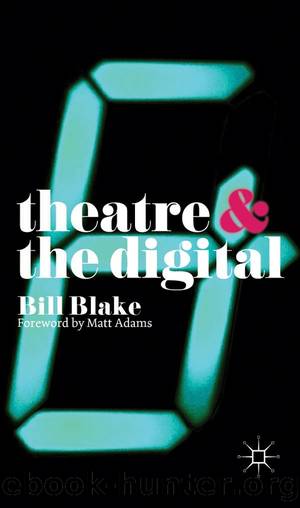Theatre and the Digital by Bill Blake

Author:Bill Blake [Blake, Bill]
Language: eng
Format: epub
Tags: computers, General, Design; Graphics & Media, Performing Arts, theater
ISBN: 9781137355799
Google: LD2ICgAAQBAJ
Publisher: Macmillan International Higher Education
Published: 2014-10-02T00:03:29.511541+00:00
Theatre apps
Neworld Theatreâs PodPlays project is an example of a digital theatre application. An application in the sense of âapplied theatreâ, which theatre professor Judith Ackroyd defines as any theatre work which shares âa belief in the power of the theatre form to address something beyond the form itselfâ (âApplied Theatre: Problems and Possibilitiesâ, 2000; quoted in Helen Nicholson, Applied Drama: The Gift of Theatre, 2005, p. 3). The PodPlays are also applications in the digital sense, insofar as they are packaged and sold as iPod apps.
The incisiveness of theatre outreach can often resemble commercialism. Aside from the good intentions, the goal of making new and useful theatre that appeals to non-theatre-going audiences is, by definition, a type of publicity cause. On the one hand, there is reason to believe in the democratic ambitions of releasing theatre from its at-thetheatre rituals, moving the theatre to the masses. Walter Benjamin, reflecting on the age of mechanical reproduction eighty years ago, expressed a cautious optimism about the potential for freeing art and cultural participation from its formal, material, and institutional rootedness. Publicity, from a liberatory outlook of this sort, is about making public theatre open to all, and making it accessible, not just available.
On the other hand, as the cultural anthropologist Greg Urban argues in Metaculture: How Culture Moves through the World (2001), such hopes for broadening circulation are also âat the heart of the expansion of capitalâ (p. xiv). Accessibility is not sufficient; promising new platforms for cultural outreach ultimately depend on creating a demand for the works they produce. But not just the works, which is where Urbanâs notion of âmetacultureâ comes in: creating interest in the actual works is only one kind of âdemand structureâ. Another kind is the demand for having something to talk about, which newspapers, journals, magazines, and blogs rely on to attract audiences of their own. The culture industry, according to Urban, depends as much on an economy of discussion between theatre makers and reviewers as it does on an economy of exchange between theatre makers and audiences. Promising new works, even without reaching actual theatregoers, have special value because they are great for keeping up a discourse about newness. The market for commentary and reviews revolves around the production and discussion of a constantly renewed sense of the new. Urbanâs word for this is âmetacultureâ: the strand of our culture that supplies ânewnessâ to cultural objects by talking about them in relation to other interesting social phenomena and cultural trends. What is produced is interest, both in the talk itself and in the object being talked about. âIn order for [a] review to circulate,â Urban writes, âit must be seen as an interesting responseâ:
By attracting more readers, a successful review will increase its own circulation; it will also impart that interest to the [cultural object], thereby increasing demand for it. In this case, culture and metaculture end up reinforcing each otherâs circulatory potential. ... The culture of modernity depends upon the creation of social
Download
This site does not store any files on its server. We only index and link to content provided by other sites. Please contact the content providers to delete copyright contents if any and email us, we'll remove relevant links or contents immediately.
Kathy Andrews Collection by Kathy Andrews(11765)
The remains of the day by Kazuo Ishiguro(8887)
Spare by Prince Harry The Duke of Sussex(5138)
Paper Towns by Green John(5136)
The Body: A Guide for Occupants by Bill Bryson(5027)
Industrial Automation from Scratch: A hands-on guide to using sensors, actuators, PLCs, HMIs, and SCADA to automate industrial processes by Olushola Akande(5024)
Machine Learning at Scale with H2O by Gregory Keys | David Whiting(4258)
Be in a Treehouse by Pete Nelson(3996)
Never by Ken Follett(3880)
Harry Potter and the Goblet Of Fire by J.K. Rowling(3808)
Goodbye Paradise(3761)
Into Thin Air by Jon Krakauer(3347)
The Remains of the Day by Kazuo Ishiguro(3345)
Fairy Tale by Stephen King(3307)
The Cellar by Natasha Preston(3296)
The Genius of Japanese Carpentry by Azby Brown(3254)
120 Days of Sodom by Marquis de Sade(3226)
The Man Who Died Twice by Richard Osman(3040)
Drawing Shortcuts: Developing Quick Drawing Skills Using Today's Technology by Leggitt Jim(3037)
